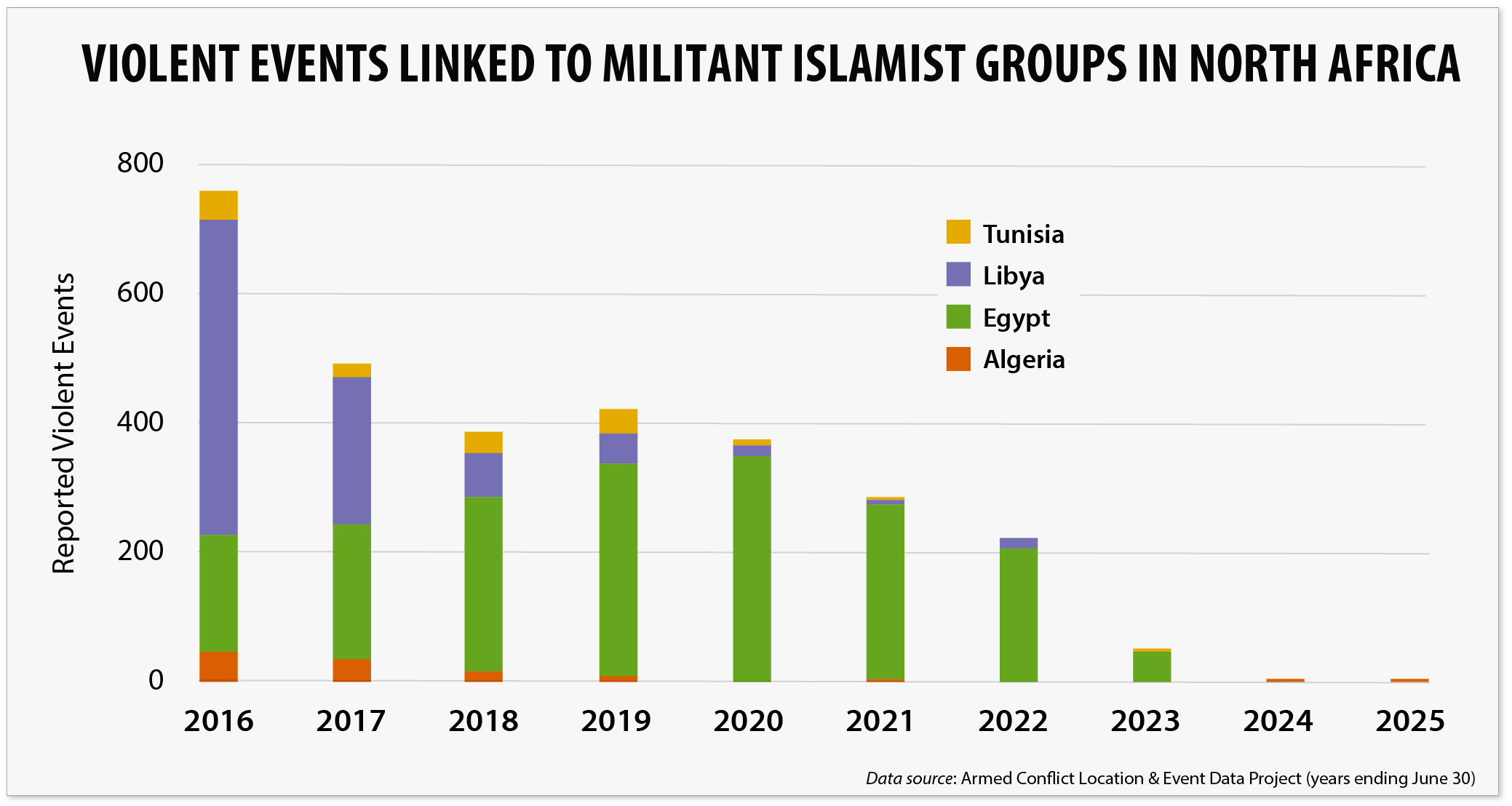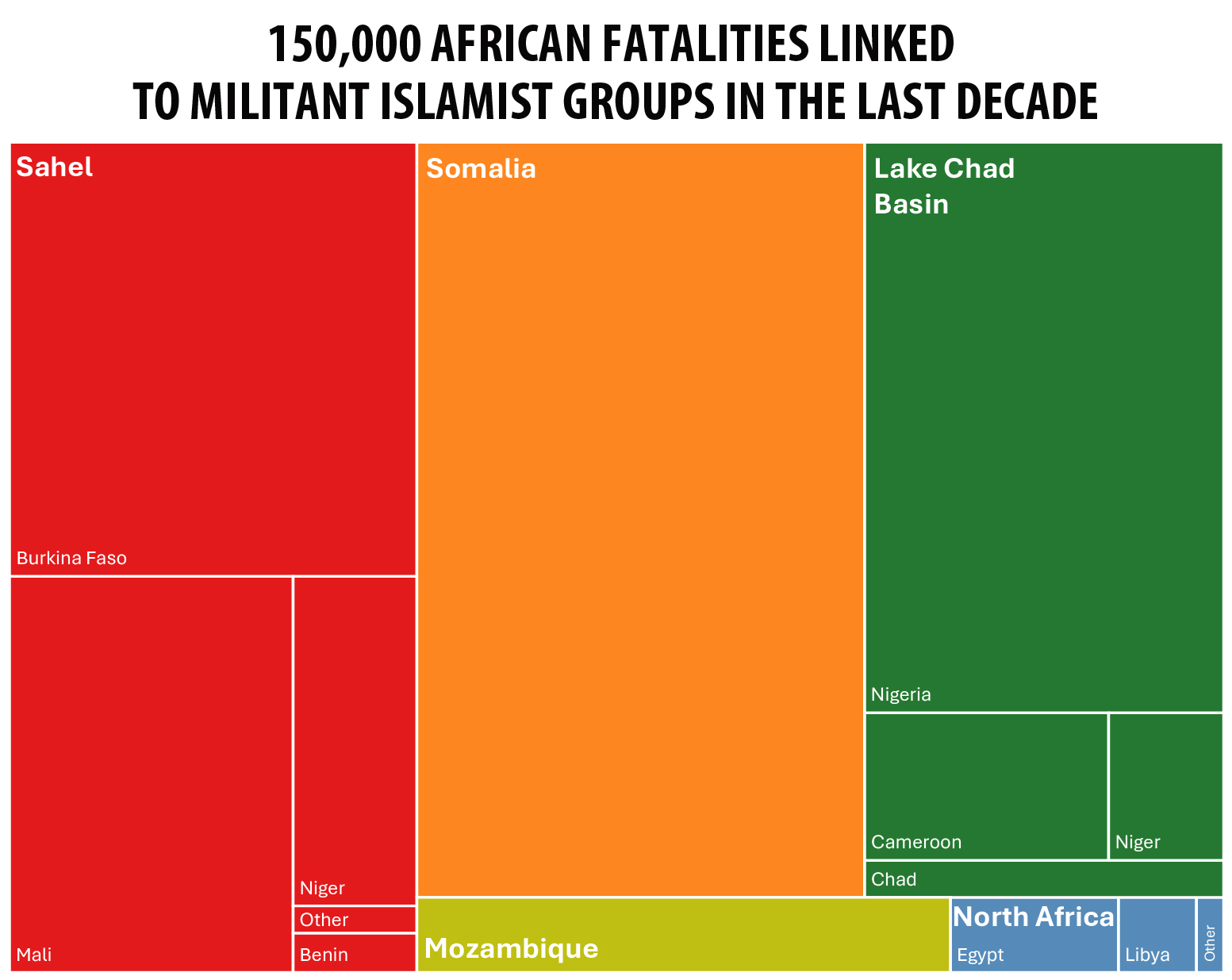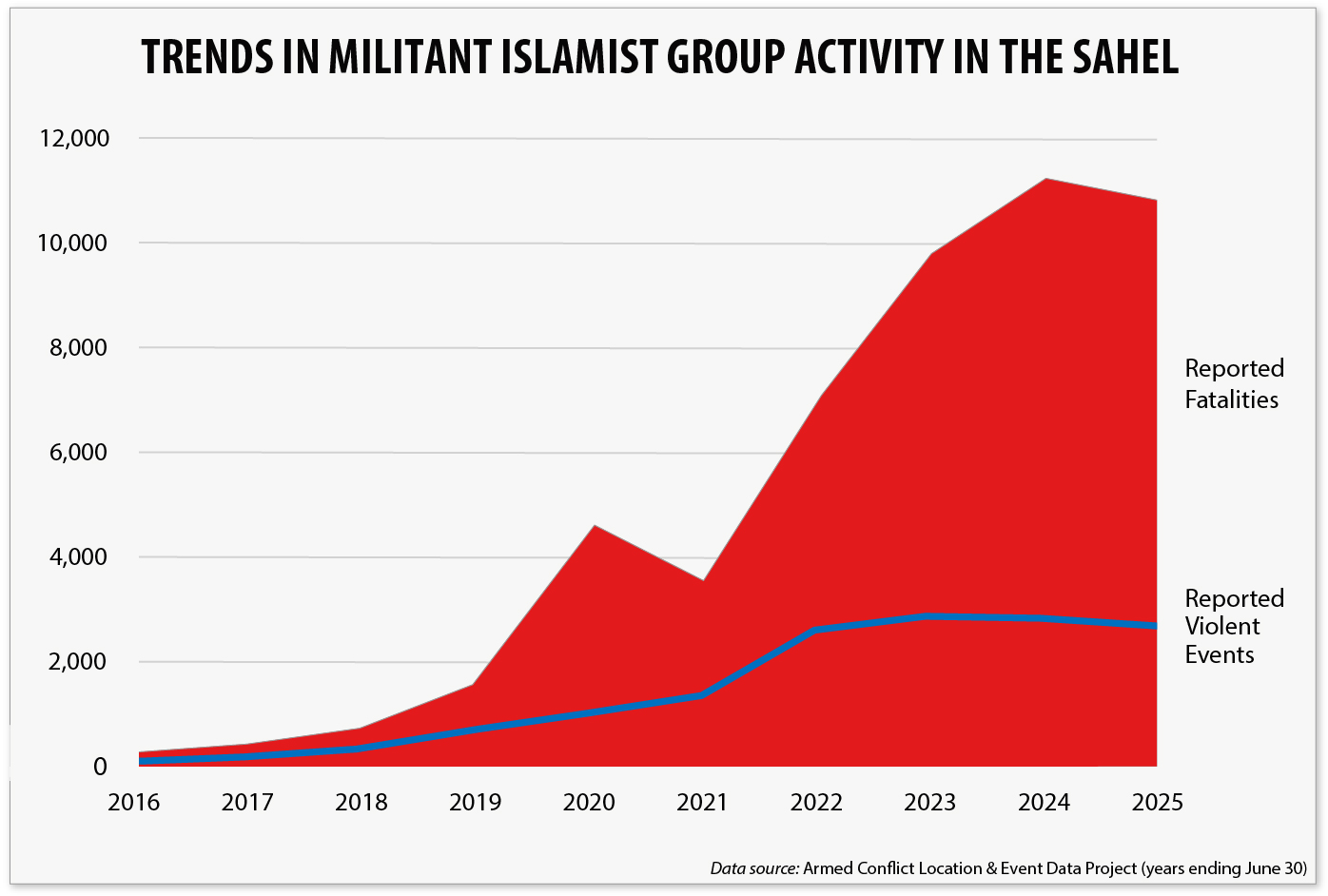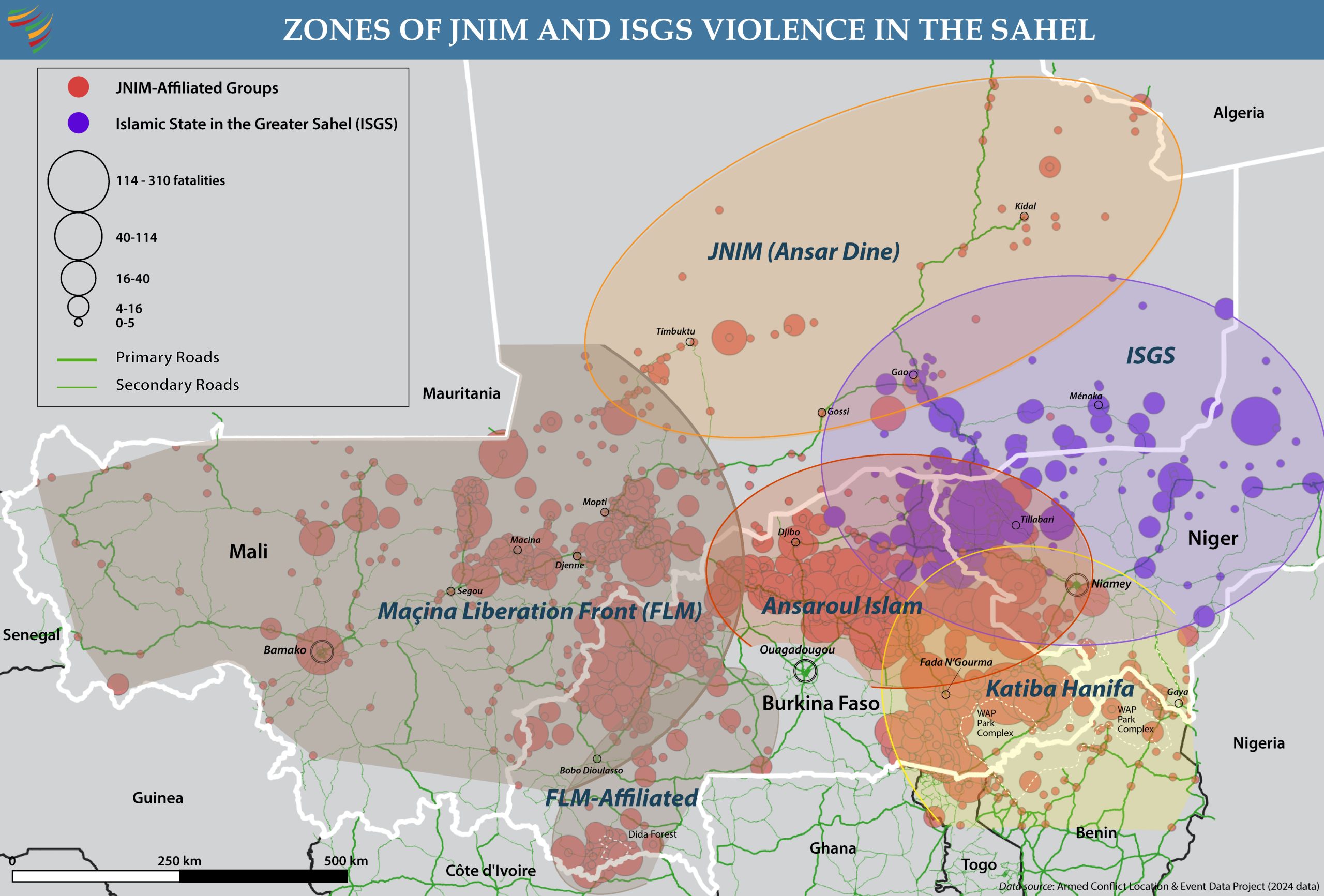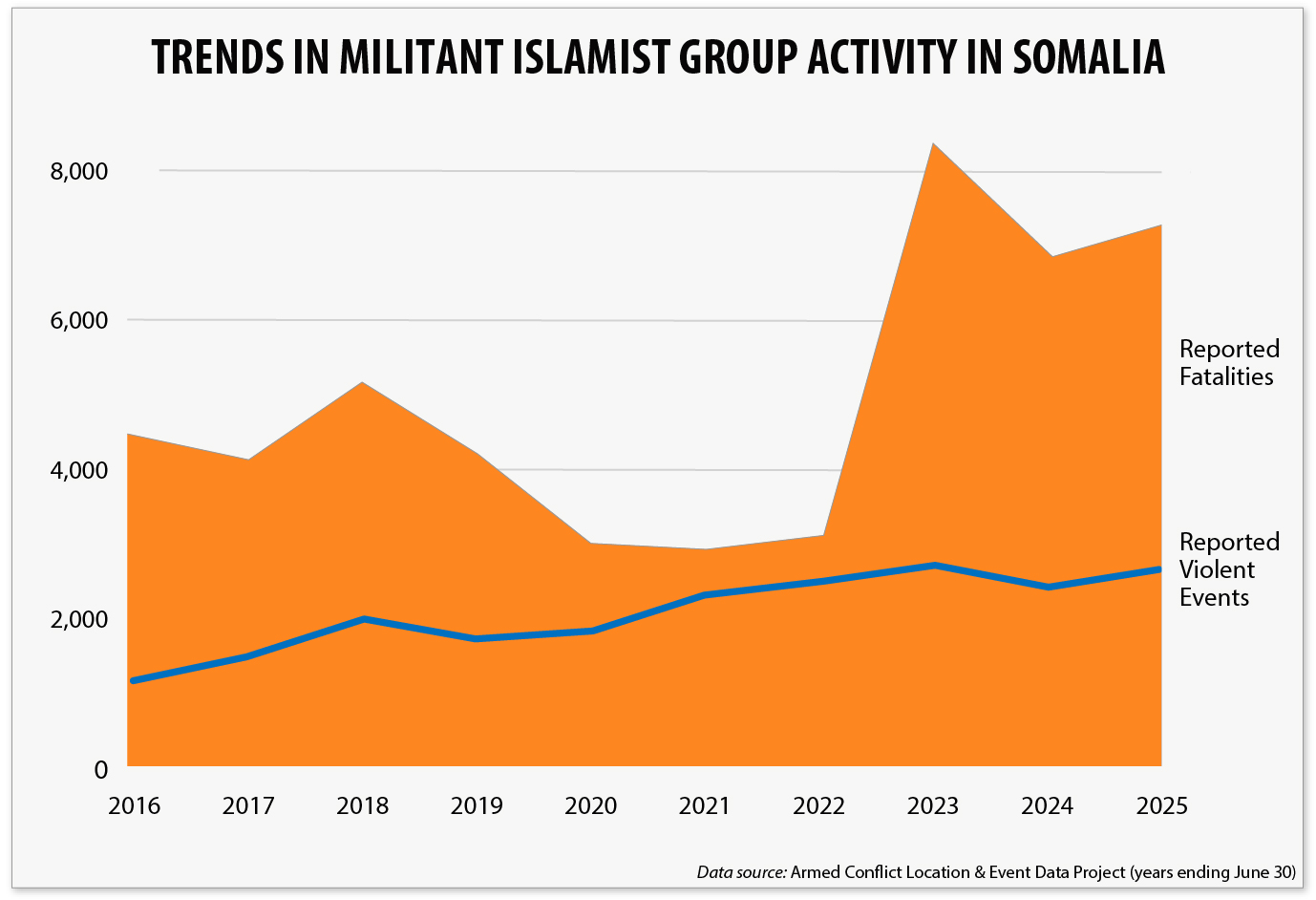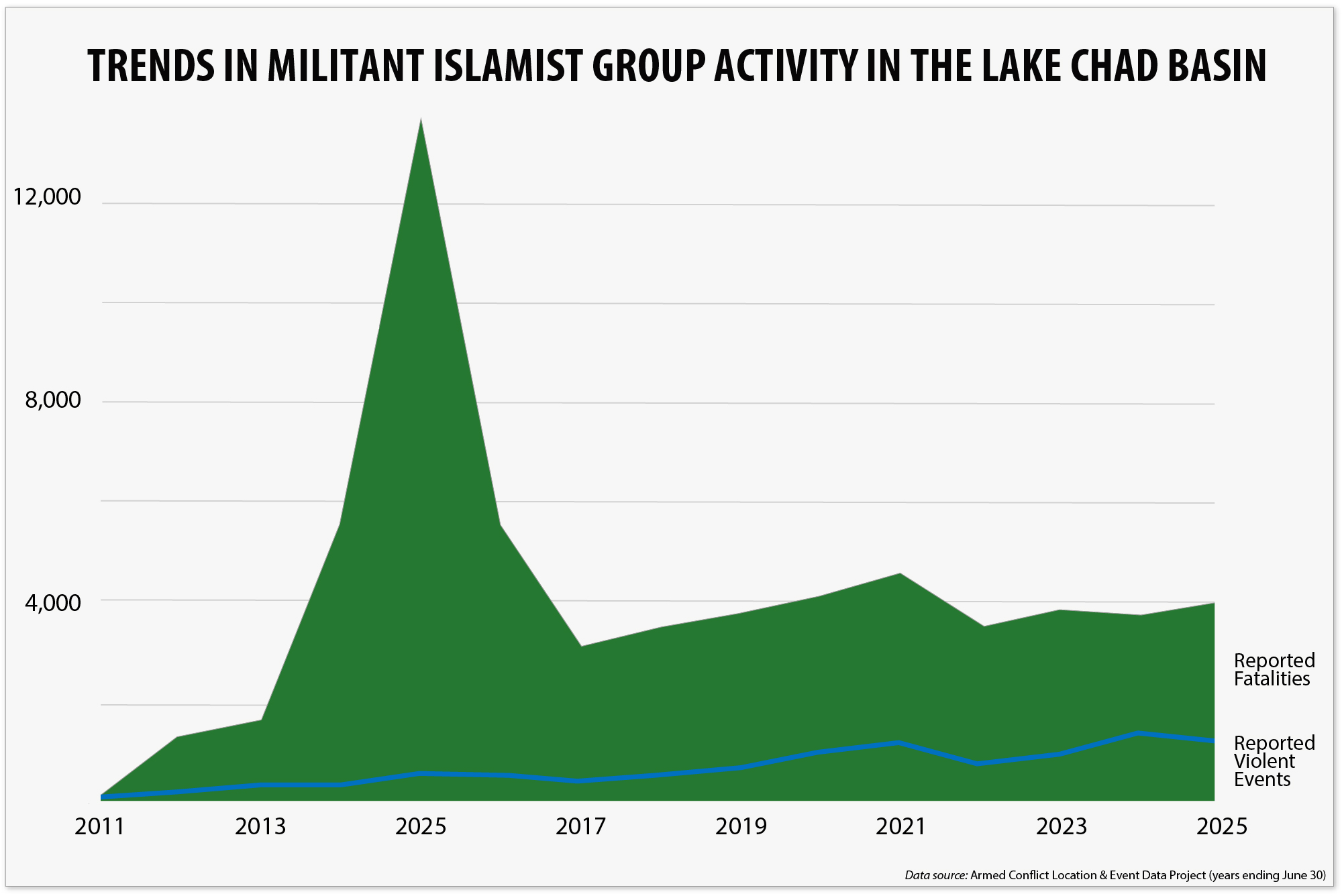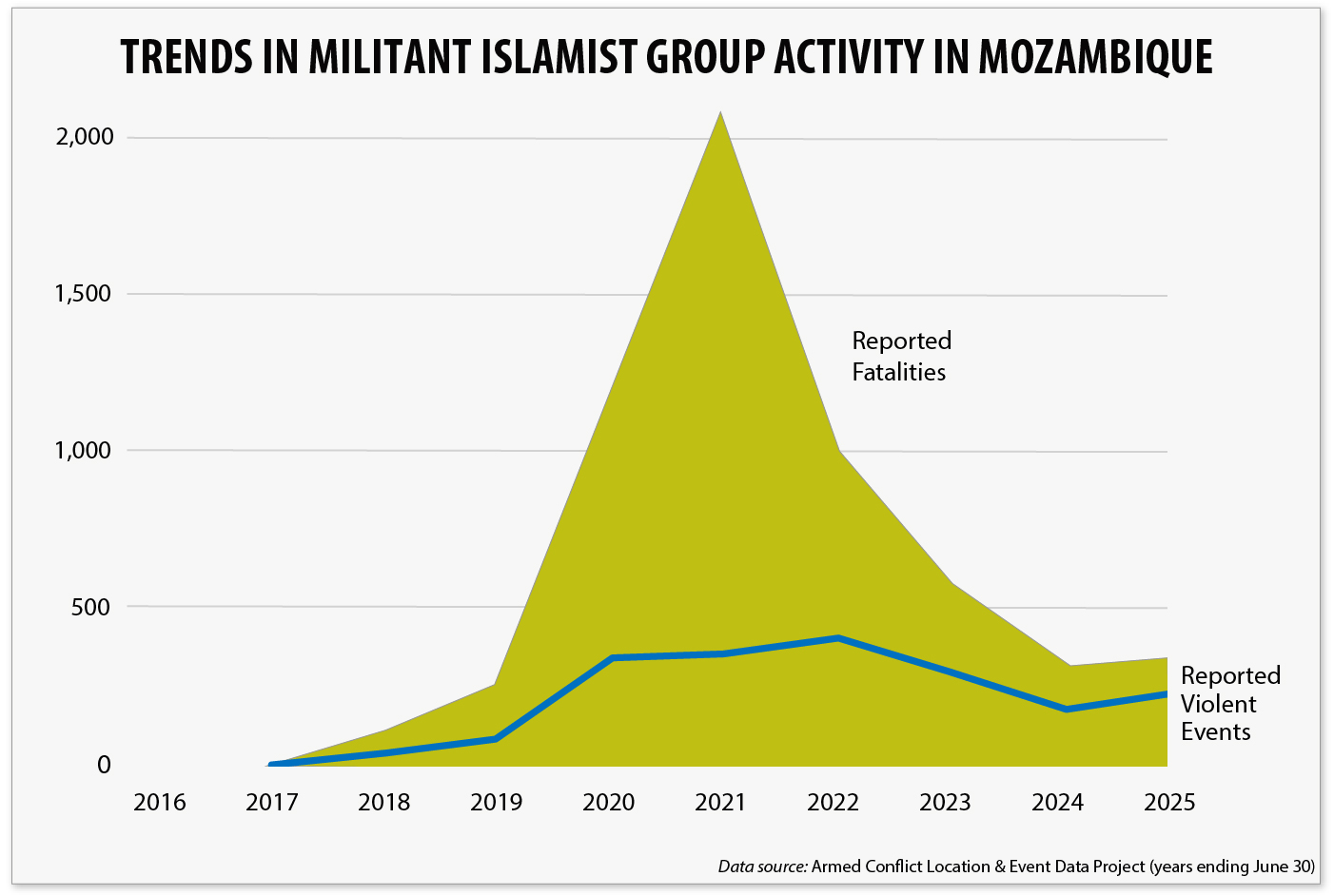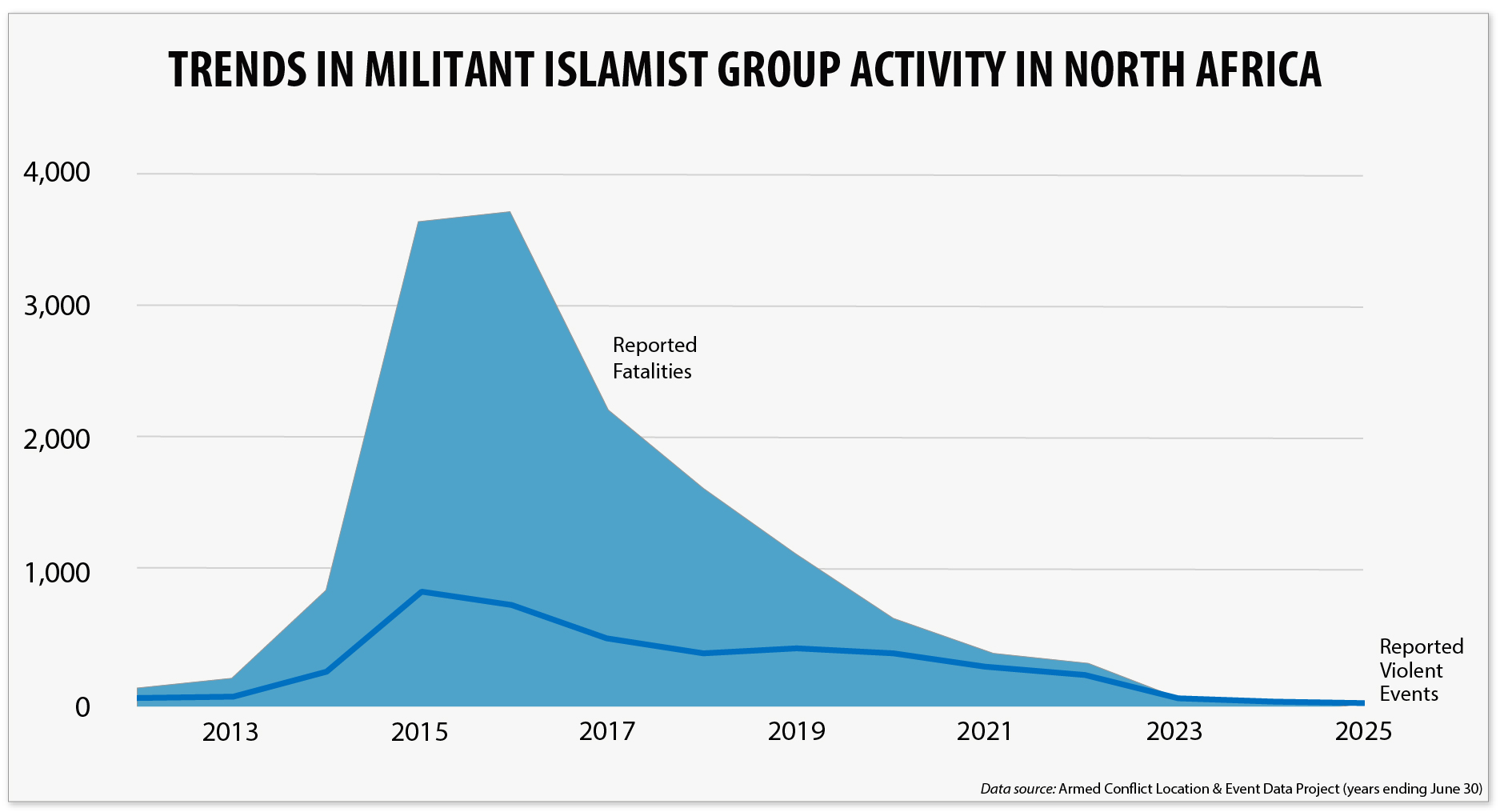English | Français | العربية
Highlights
Militant Islamist groups in Africa continue to be highly active agents of instability across five theaters on the continent. The 22,307 fatalities linked to these groups over the past year sustain a record level of lethality observed since 2023 and represent a 60-percent increase from the 2020-2022 period.
Nearly half of the fatalities (10,685) in the past year have been in the Sahel. Somalia represents roughly a third of the continental fatalities (7,289). Along with the Lake Chad Basin, these three regions account for 99 percent of the militant Islamist-linked fatalities in Africa the past year.
Battle-related fatalities have increased in every theater over the past year.
All five African theaters (including Mozambique and North Africa) remain highly dynamic with militant insurgents mounting offensive operations in each, especially in the Sahel and Somalia. Battle-related fatalities have increased in every theater over the past year—resulting in a 14-percent rise of battle-related deaths across the continent (15,678).
The past year has also seen militant Islamists groups in the Sahel and Somalia expand their hold on territory. Across Africa, an estimated 950,000 square kilometers (367,000 square miles) of populated territories are outside government control due to militant Islamist insurgencies. This is equivalent to the size of Tanzania.
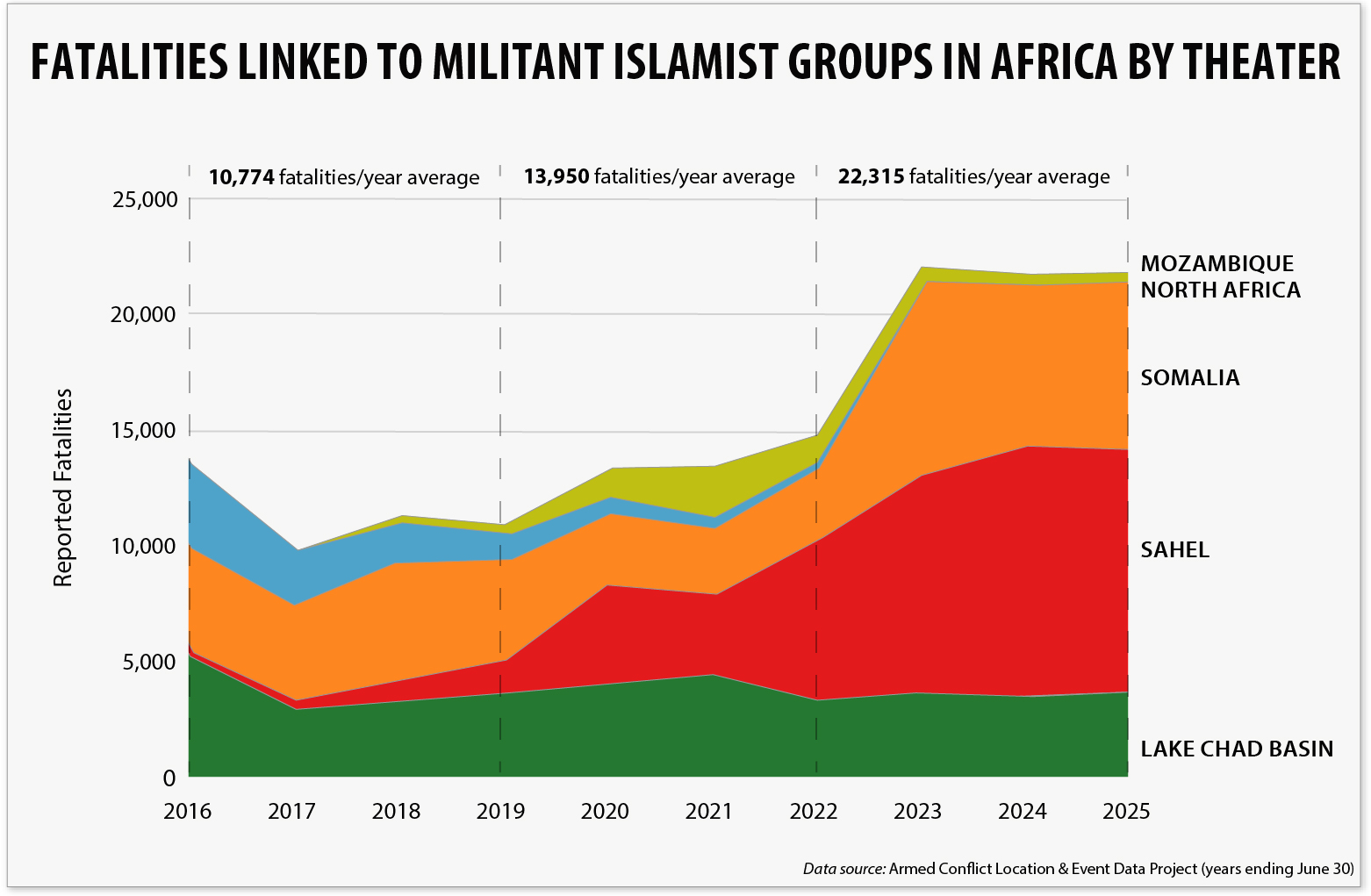
Over the past decade, Somalia and the Lake Chad Basin countries (Nigeria, Cameroon, Chad, and southeastern Niger) have been the two theaters that have consistently experienced the greatest levels of violence—each typically accounting for at least a quarter of all annual fatalities. This shifted in 2022 with the surge of fatalities in the Sahel. As a result of the rapid deterioration of security in the Sahel, Somalia and the Sahel have now experienced more militant Islamist-related fatalities over the past decade (each over 49,000) than any other region. The Lake Chad Basin countries have suffered an estimated 39,000 fatalities over this timeframe. Collectively, Africa has experienced roughly 155,000 militant Islamist group-linked deaths over the past decade.
These shifts highlight the constant evolution of the militant Islamist threat in Africa and the importance of understanding the unique dynamics within each of these theaters.
- The Sahel has experienced a sustained high level of lethality tied to militant Islamist groups in recent years. The nearly 10,500 average annual deaths over the past 3 years are more than double the 4,900 annual fatalities experienced between 2020 and 2023. This represents a sevenfold increase in annual fatalities since 2019.
- The pace and scale of violence in the Sahel is likely even higher than reported, given that the military juntas that seized power in Mali, Burkina Faso, and Niger have restricted media access within the region, which is the main source of conflict data.
- Militant Islamist groups linked to the Jama’at Nusrat al Islam wal Muslimeen (JNIM) network account for 83 percent of all fatalities in the Sahel. Led by the Macina Liberation Front and Ansar Dine, these JNIM groups primarily operate in north, central, and southern Mali and southern Burkina Faso. Comprising an estimated 6,000-7,000 fighters (the vast majority of whom are from the Sahel), these groups are also pushing into the border areas of the coastal West African countries.
- The Islamic State in the Greater Sahara (ISGS) is the other main militant Islamist threat in this region, largely concentrated in northern Burkina Faso and western Niger. With an estimated 2,000-3,000 fighters, ISGS is both a rival to and cooperative with JNIM.
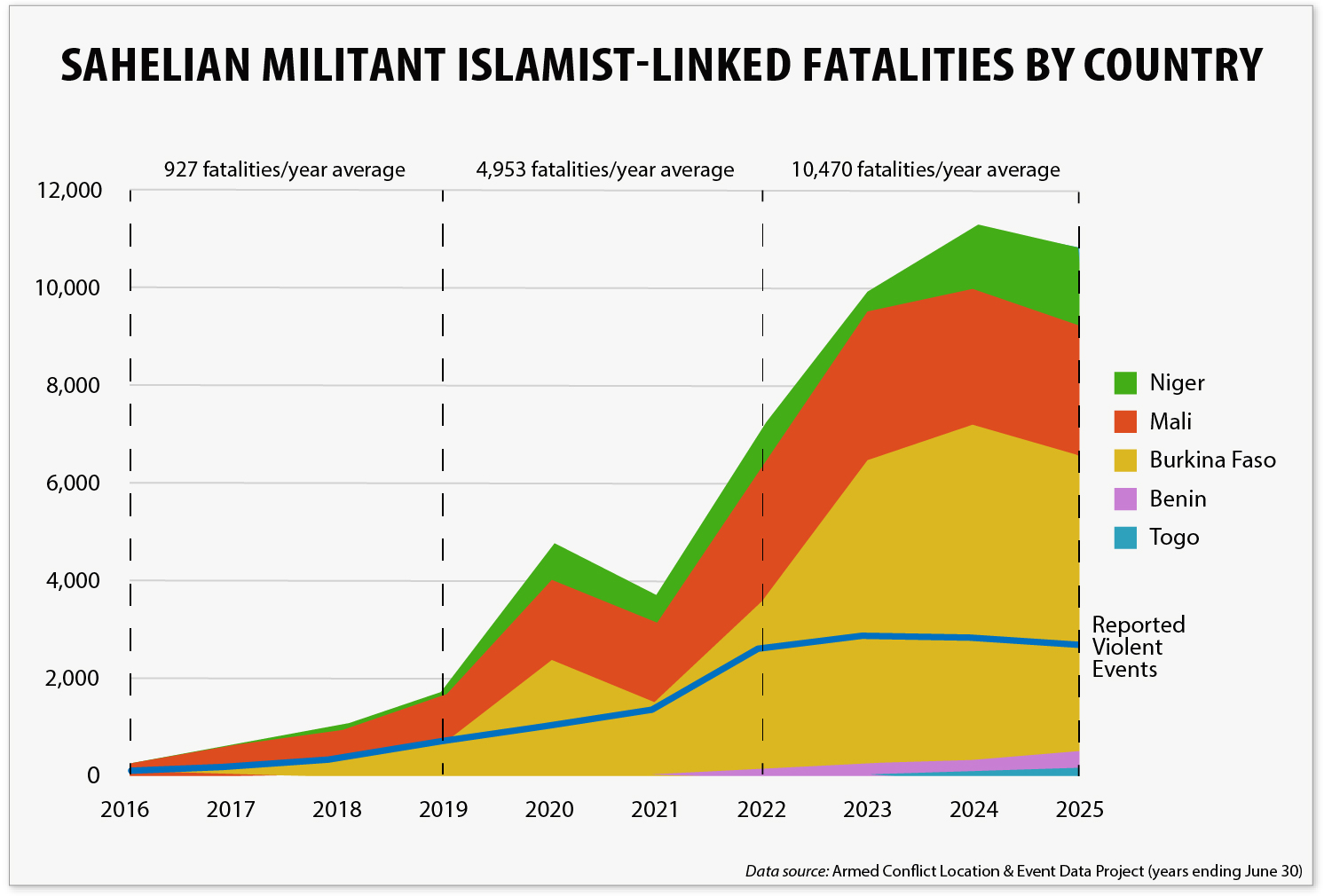
- For the last 4 years, Burkina Faso has been the epicenter of violent events and fatalities linked to militant Islamist groups in the Sahelian theater. In the past year, Burkina Faso accounted for 55 percent of these fatalities.
- The deteriorating security situation in Burkina Faso is accompanied by a growing loss of territory to the militant groups. It is estimated that Burkinabe forces now only control 40 percent of national territory. Similar patterns are observed in Mali, with JNIM-linked forces intensifying operations in central regions of the country and attacking areas along the borders with Côte d’Ivoire, Guinea, Senegal, and Mauritania.
It is estimated that Burkinabe forces now only control 40 percent of national territory.
- Mali was the original Sahelian country targeted by militant Islamist groups, including Al Qaeda in the Islamic Maghreb (AQIM), Ansar Dine, and MUJAO, starting in the late 2000’s. Mali has endured an estimated 17,700 fatalities since then. Roughly 81 percent of those fatalities (14,384 deaths) have occurred since 2020 when Mali suffered a military coup. This includes an estimated 2,650 fatalities in the past year, accounting for 25 percent of all fatalities in the Sahel theater.
- Mali saw a 71-percent increase in remote violence fatalities (to 499) linked to JNIM groups over the past year. In addition to greater use of improvised explosive devices (IEDs), this supports reports that JNIM has enhanced their access to drones—expanding the scale and scope of their threat to civilians and security forces in the region.
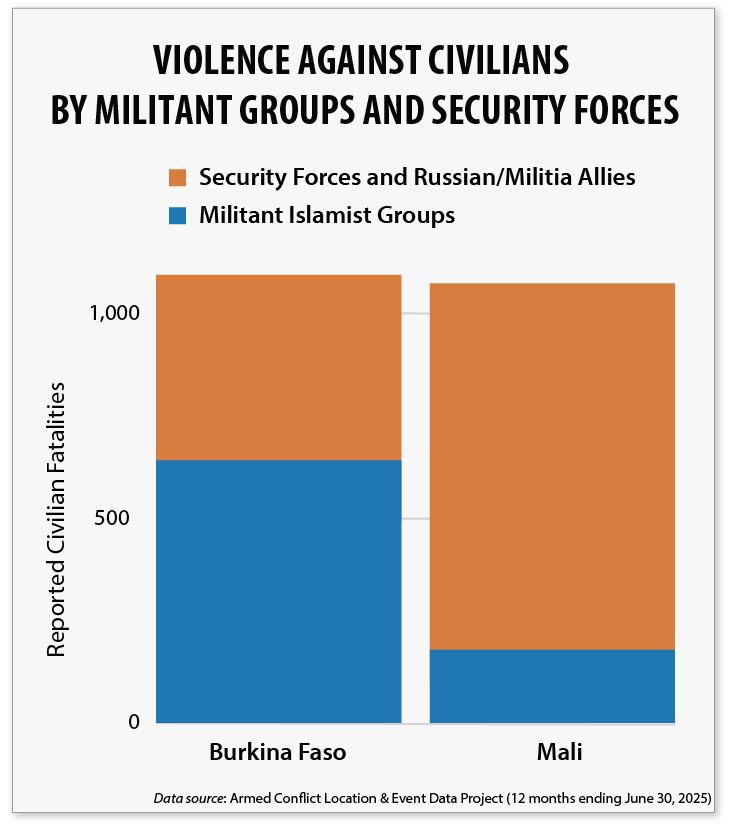
- Civilians in Mali and Burkina Faso must also contend with predatory violence from security forces and Russian Wagner and Africa Corps paramilitaries. For the last 4 years, there have been a reported 1,292 such attacks, causing 6,058 fatalities. This exceeds the 5,708 civilian fatalities linked to militant Islamist groups in the two countries over this timeframe.
- Malian and allied security forces were responsible for 82 percent of all civilian fatalities over the past year. In Burkina Faso the figure is 41 percent. The targeting of civilians (largely of the Fulani ethnic group) by Malian, Burkinabe, and Russian forces is unparalleled relative to any other region in Africa and is a key driver to JNIM recruitment.
Mali has endured an estimated 17,700 fatalities … Roughly 81 percent of those fatalities have occurred since 2020.
- To capitalize on abuses by security forces, JNIM has portrayed itself as a defender of marginalized populations and disseminated videos of abuses by security forces to reinforce their lack of legitimacy and accountability.
- Niger has been experiencing a rapid deterioration in its security since the military coup against the democratic government of President Mahmoud Bazoum in 2023. Since that time, fatalities linked to militant Islamist violence have quadrupled (to 1,655 deaths). This includes a 49-percent increase in civilian deaths over the past year.
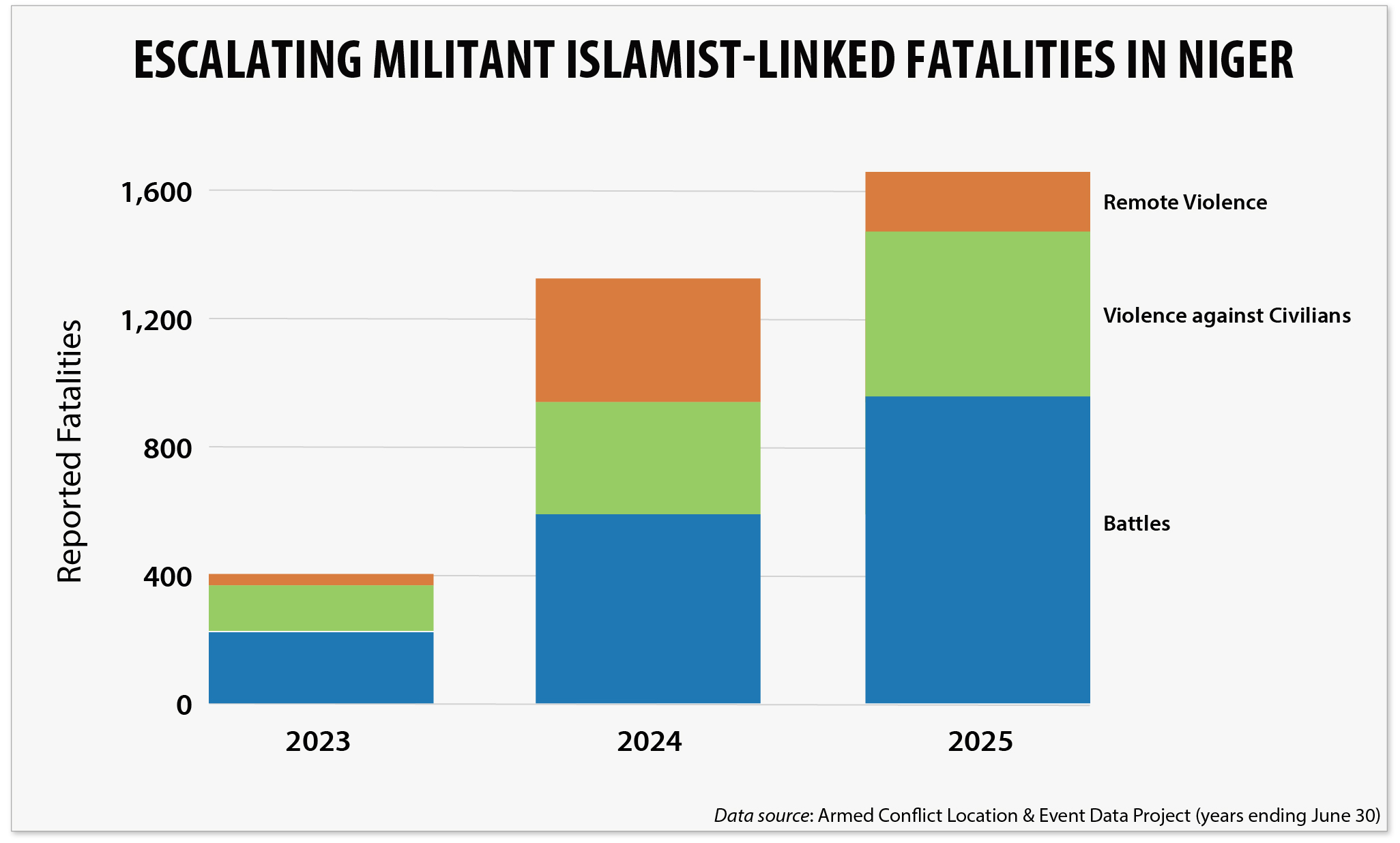
- Niger has also experienced a 61-percent spike in battle-related fatalities, reflecting the growth in the frequency and scale of ISGS attacks on Nigerien security forces.
- Indicative of the growing pressure on coastal West African countries, Benin saw a 129-percent increase in militant Islamist-linked fatalities over the past year (to 374)—a record high. Togo, similarly, saw a more than doubling of annual deaths (to 101), continuing an upswing of extremist violence in coastal West African countries since 2022.
- Due to the growing instability, the number of forcibly displaced people in the region is now over 3.5 million—a figure that is likely much higher given lack of independent reporting and the failure of military authorities in Burkina Faso to update these figures since 2023.
- Somalia faces Africa’s most enduring militant Islamist group with al Shabaab sustaining extremist violence since it was established in 2006. Al Shabaab is an offshoot of earlier Salafist groups formed in the 1990s whose aim is to create a “Greater Somalia” under Islamist rule. With allegiance to the al Qaeda network, al Shabaab has expressed a commitment to global jihad and has attacked Western interests in the Horn of Africa region.
- Drawing from extortion, toll roads, property taxes, and piracy, among other sources, al Shabaab generates up to $200 million in annual revenues—putting it on par with Somalia’s federal member states. Al Shabaab is believed to have 7,000-12,000 fighters under its control.
- Somalia is also the base of the Islamic State in Somalia (ISS), located in the northeastern state of Puntland. While ISS has had operations in Somalia since 2015, it has gained increased scrutiny in the past year following United Nations and other reports that ISS had emerged as an administrative and financial hub for ISIS globally. These reports indicate that ISS had escalated its recruitment of foreign fighters (swelling its ranks from some 200 in 2018 to an estimated 1,000 in 2025).
- Somalia has seen a spike in violence linked to al Shabaab since 2023—owing to a military offensive against the group following the election of President Hassan Sheikh Mohamud and the ensuing counteroffensive by al Shabaab in 2024 and 2025. The 6,224 fatalities linked to al Shabaab over the past year are double that of 2022.
Somalia represents roughly a third of the continental fatalities linked to militant Islamist groups.
- Estimates are that al Shabaab capabilities have expanded in the past year due to an increasingly cooperative relationship with Yemen’s Houthis. This cooperation has translated into improved materiel (including drones and ballistic missiles) and training for al Shabaab, which is believed to have directly contributed to their successful offensive operations in central and southern Somalia.
- Since November 2023, there have been 47 piracy-related events in the Gulf of Aden and Western Indian Ocean. Alongside the Houthi missile attacks on vessels in the Red Sea, the piracy mounted by al Shabaab has greatly disrupted commercial shipping traffic through the Bab al Mandab Strait and caused billions of dollars in economic losses and increased costs.
- There has also been an unprecedented spike in attacks involving ISS over the past year, resulting in an estimated 1,065 fatalities. (In previous years, ISS-linked fatalities have been under 100). Most of this activity was related to operations by Puntland security forces against ISS in the Cal-Miskaad Mountains, supported by airstrikes from the United Arab Emirates and the United States.
- An estimated 72 percent of militant Islamist-linked fatalities in Somalia are from battles—demonstrating the coordinated nature of the fighting. Fatalities involving violence against civilians, in contrast, are relatively low (an estimated 102 deaths over the past year), comprising just 2 percent of the total.
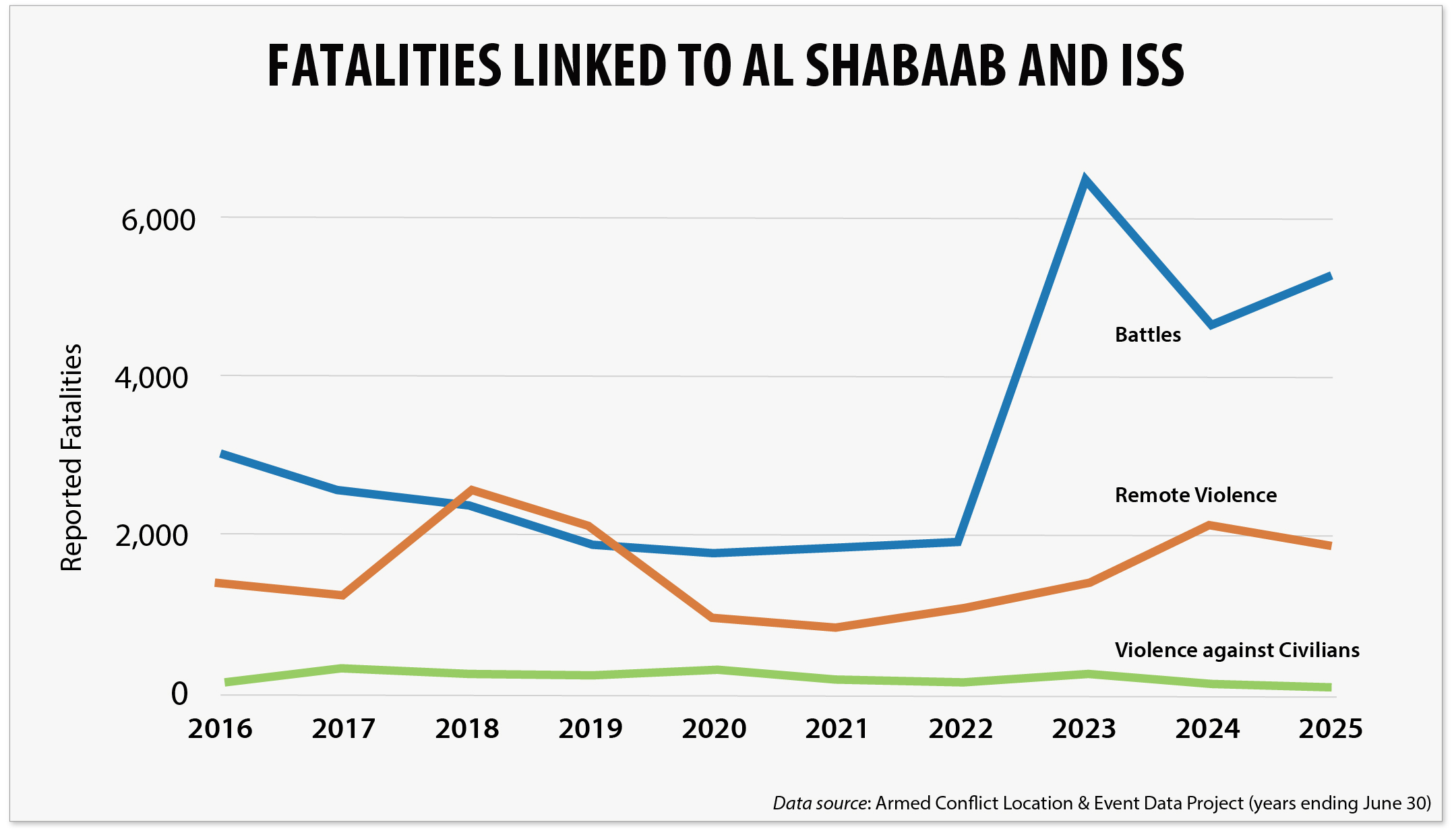
- The Lake Chad Basin saw a 7-percent increase in fatalities (3,982) linked to militant Islamist violence over the past year, demonstrating the continued resilience of Jama’atu Ahlis Sunna Lidda’Awati Wal Jihad (Boko Haram) and the Islamic State in West Africa (ISWA). The region accounts for 18 percent of total fatalities linked to militant Islamist groups on the continent.
- For perspective, the annual fatalities in the region represent a 50-percent decline from the levels experienced from 2014 to 2016 when Boko Haram was most lethal. Boko Haram launched its first violent attacks in 2009.
- Boko Haram and ISWA have faced ongoing rivalries and leadership changes since ISWA broke away in 2015. Today, both groups are loosely organized around multiple cells, mostly operating in northeastern Nigeria. Estimates are that Boko Haram commands some 1,500-2,000 fighters while ISWA has between 4,000 and 7,000.
- Both Boko Haram and ISWA appear increasingly well organized and equipped. Over the past year, ISWA overran 15 Nigerian military bases and, in a first, used night vision technology to launch attacks on these bases. It has also gained the operational expertise to deploy armed and surveillance drones, shifting the battlefield in the region. The groups were linked to roughly equal numbers of fatalities.
Both Boko Haram and ISWA appear increasingly well organized and equipped.
- Nigeria experienced an 18-percent increase in fatalities tied to militant Islamist groups over the past year. Borno State in Nigeria’s North East Zone remains the epicenter of this violence and Nigeria accounts for 74 percent of all fatalities in the region.
- Cameroon experienced 12 percent of the fatalities (467 deaths) linked to militant Islamist groups in the theater over the past year. However, this reflects a 45-percent drop from the previous year—the only country in the region realizing a positive trajectory. In contrast, Chad has experienced a more than doubling in the number of fatalities (to 242) over the past year, resulting in more deaths than in any year since 2020. In one event, Boko Haram deployed a female suicide bomber to kill at least 40 soldiers at the Chadian military base in Barkaram.
- Militant Islamist cells have also moved into northwestern Nigeria in recent years, which heretofore has been primarily the domain of organized criminal gangs (commonly referred to as “bandits”), who have engaged in kidnapping for ransom, extortion, and the seizure of farms and mines. Operating mainly in Sokoto and Kebbi States, the Lakurawa group was initially recruited by local communities to deal with banditry in the area but ended up cooperating with and operating more like bandits themselves. Lakurawa is suspected to have now established links with militant Islamist groups in the region. Comprising an estimated 200 fighters, Lakurawa is well-equipped with, among other tech, unmanned aerial vehicles for surveillance and satellite communications equipment. It was linked to 134 fatalities in the past year.
- The Mahmuda group settled in the Kainji Lake National Park in 2020 after raiding it and driving away its guards. Kwara State residents said the group started as a religious body, giving sermons about their form of Islam. The Nigerian military has called Mahmuda a Boko Haram splinter Mahmuda is associated with 24 deaths in the past year.
- Given the growing level of instability in Nigeria’s North West Zone, there is also growing concern over linkages between Sahelian militant groups, especially ISGS, with Lakurawa and Mahmuda as well as ISWA in the North East.
- While often conflated with the militant Islamist groups, the bandits operating in northwestern Nigeria pose a distinct threat to instability in this region not captured in these figures. Collectively, they are estimated to be responsible for roughly the same number of fatalities as Boko Haram and ISWA in the North East Zone.
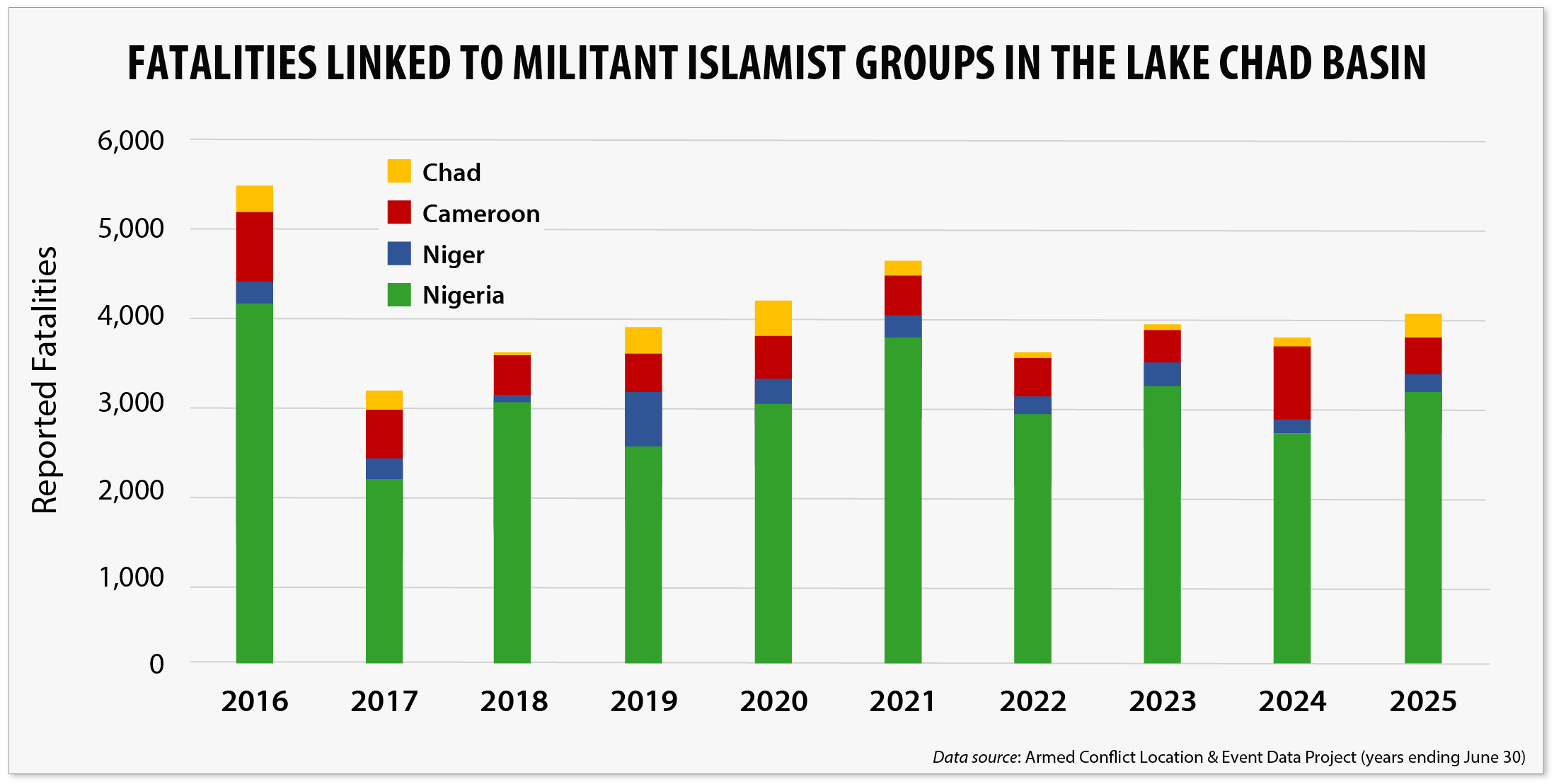
- The Lake Chad region has experienced a 32-percent increase in fatalities linked to militant Islamist violence against civilians in the past year, continuing a trend since 2023. Violence against civilians is typically employed as a tactic of intimidation when militants are attempting to assert obeisance. The 880 deaths represent the highest level of violence against citizens since 2016 and underscore the fragmentation of these groups as well as their lack of popular support.
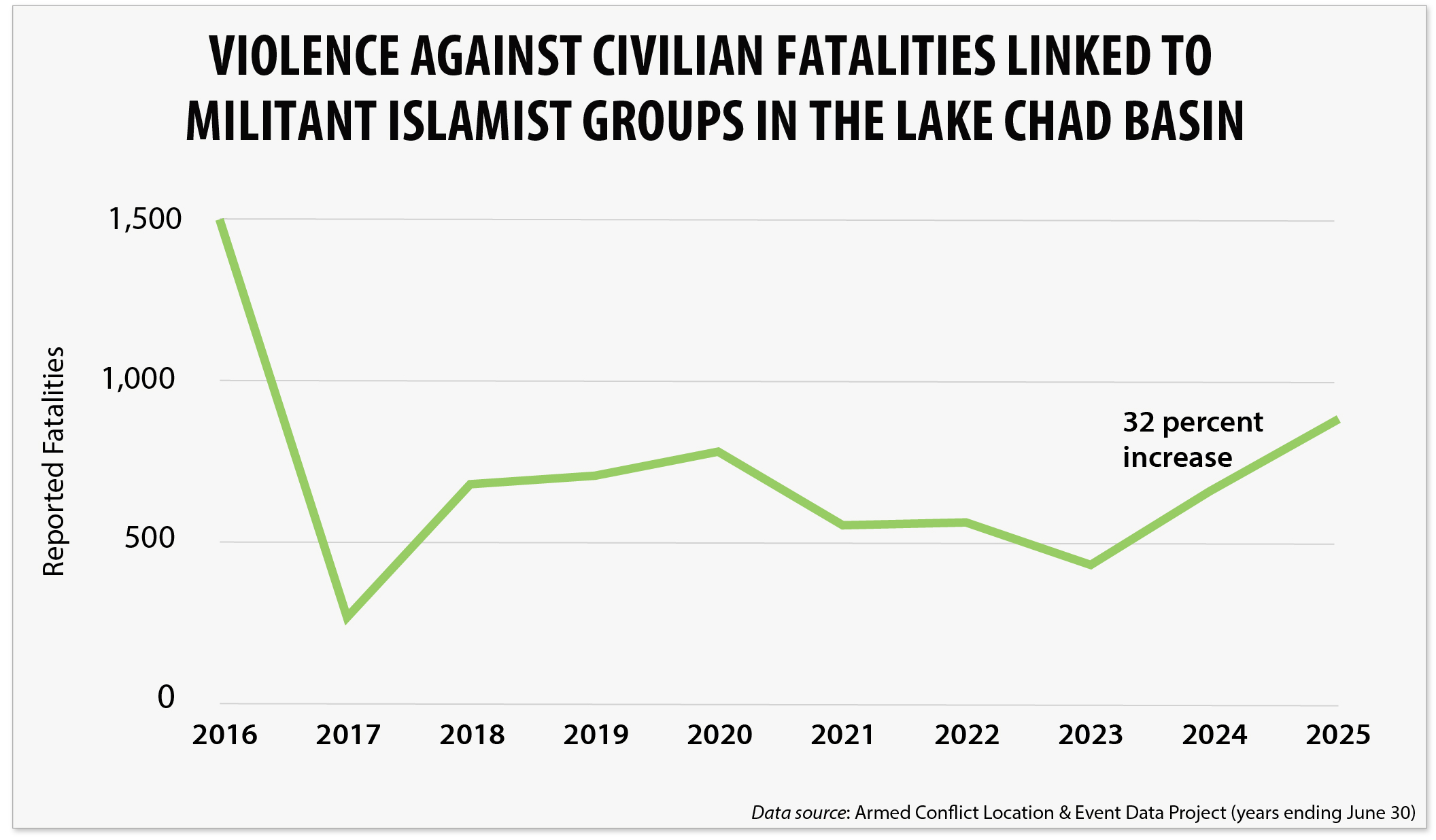
- Fatalities linked to militant Islamist violence in Mozambique (330 deaths) have declined six-fold from their peak of 2,076 deaths in 2021.
- This threat was largely tamped down by the arrival in 2021 of Southern African Development Community (SADC) and Rwandan security forces. With the ending of the SADC mission in July 2024, it remains to be seen whether this downward trajectory can be maintained.
- Comprising an estimated 200-300 fighters, Ahl al Sunna wal Jama’a (ASWJ) (referred to locally as al Shabaab) appears to be among the least cohesive militant Islamist groups on the continent.
- ASWJ, nonetheless, continues to show resilience. In March 2025, ASWJ fighters took advantage of the post-electoral unrest in the country to conduct attacks on the main road connecting Pemba to the districts in the north, raid artisanal gold mines, and kill civilians in Niassa Special Reserve. In May, ASWJ mounted attacks on Rwandan forces, stole weapons, and even attempted to attack a Russian-flagged vessel off the coast of Tambuzi Island. In June 2025, the Mozambican military launched an assault on ASWJ’s stronghold in the Catupa Forest, but it was rebuffed.
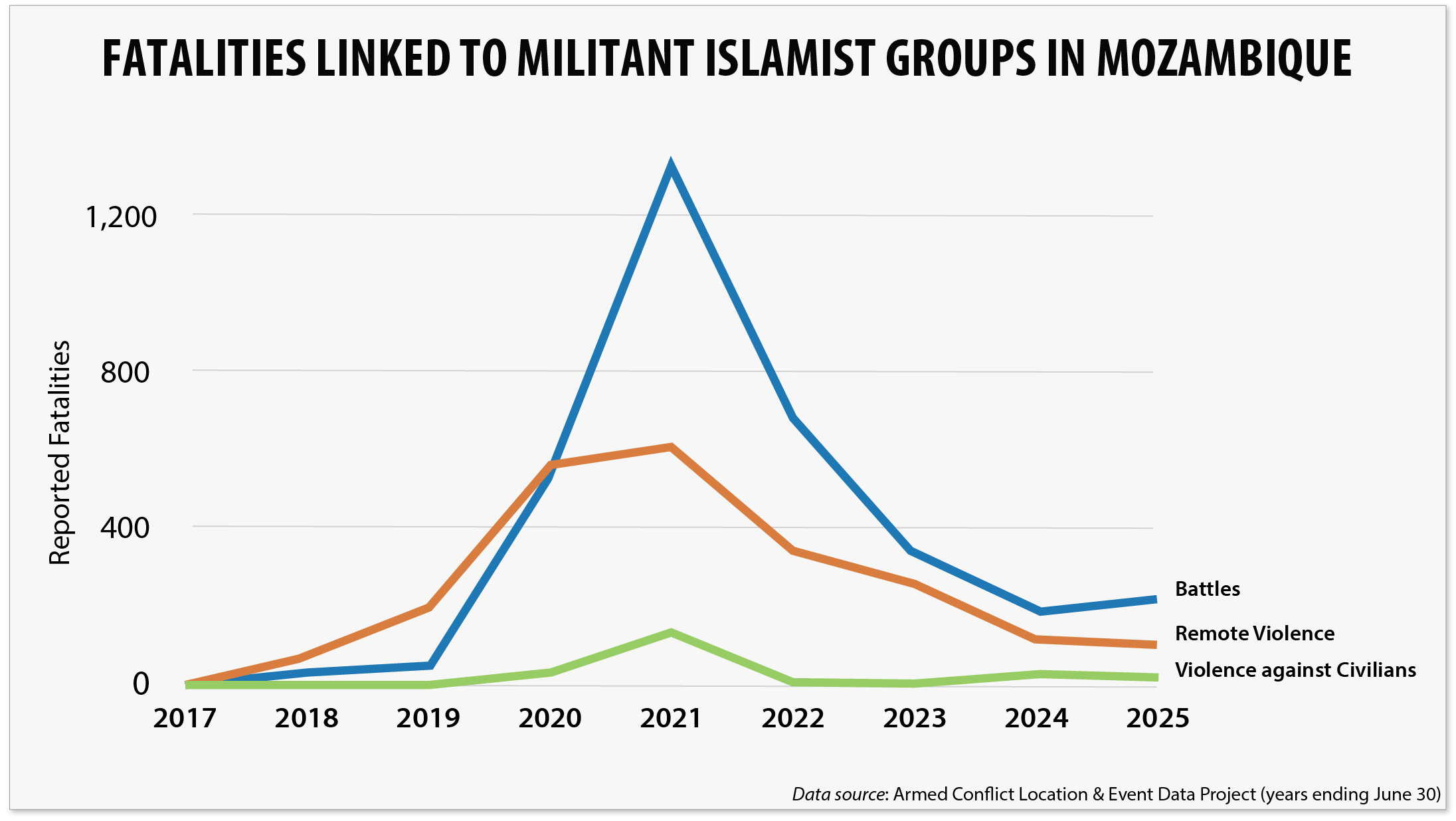
- Despite doubling its size to 4,000 troops to replace SADC forces, the Rwandan security forces have not eliminated the ASWJ Instead, there has been a rise in the number of attacks on civilians, especially along key transport arteries. As a result of the militant violence, there remain an estimated 461,237 Mozambicans displaced in the northern part of the country.
- The North African theater has seen a steady decline in violent events and fatalities linked to militant Islamist groups since 2016 when the region experienced a peak of 3,731 related deaths. For the last 3 years the number of fatalities has averaged just over 30. Most of these have been related to security force sweeps of remaining militant Islamist members at large.
- The past year saw 13 violent events and 17 fatalities, all in Algeria. Three of the events in Algeria were linked to a small cell including foreign fighters (likely from ISIS) who had come from Syria to raise funds for the global network. Prior to 2024, Egypt had been the locus of militant Islamist violence in North Africa.
- In Libya, the United Nations noted the continued presence of militant Islamist groups in the southwestern part of the country providing logistical and financial support to Sahel-based affiliates. It also reported that Libyan services apprehended two Syrian nationals who were helping to facilitate the movement of fighters from Syria to Mali through Libya.
- The incidents in Algeria and Libya underscore the enduring security concerns facing North African countries from fighters returning from abroad, and the need for continued vigilance to counter attempts to strengthen links among militant Islamist groups across the continent and globally.
